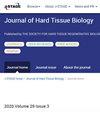Gene Expression in Early Stages of Low-Intensity Pulsed Ultrasound Exposure on Bone Marrow Cells
IF 0.4
4区 医学
Q4 ENGINEERING, BIOMEDICAL
引用次数: 0
Abstract
: The aim of this study was to identify genes that are prominently expressed in rat bone marrow cell-derived osteoblasts during the initial phase of low-intensity pulsed ultrasound (LIPUS) exposure. Bone marrow cells were obtained from three Sprague-Dawley rats (8-week-old, male), and cell cultures were prepared by suspension in osteogenic medium. After cultures were established, test cultures were exposed to LIPUS from the bottom of the cell culture plate for 15 min/d on days 1–4 (LIPUS group). LIPUS signals were transmitted at a frequency of 3 MHz and a spatial average intensity of 40 mW/cm 2 . The control group was not exposed to LIPUS. On day 14, alizarin red S staining was performed to detect calcifi -cation. On day 4, total RNA was extracted from both cultures, hybridized to microarray slides, and the resulting data set was analyzed. Genes exhibiting a fold-change ≥2 and a p-value <0.05 (LIPUS vs. control) were identified as differentially expressed genes. Pathway analysis was performed on genes whose expression increased in the LIPUS group. The cellular areas stained with alizarin red S were significantly larger in the LIPUS group than in the control group on day 14. LIPUS exposure increased the expression of genes related to type II interferon signaling, and endochondral ossification was ob served after 4 d of culture. The results demonstrated that LIPUS exposure activated the immune response and promoted osteoblast differentiation.低强度脉冲超声暴露早期对骨髓细胞的基因表达
本研究的目的是鉴定在低强度脉冲超声(LIPUS)暴露初始阶段在大鼠骨髓细胞来源的成骨细胞中显著表达的基因。取3只8周龄雄性Sprague-Dawley大鼠骨髓细胞,在成骨培养基中悬浮培养细胞。培养完成后,在第1-4天(LIPUS组)将实验培养物从细胞培养板底部暴露于LIPUS中15 min/d。LIPUS信号以3 MHz的频率和40 mW/ cm2的空间平均强度传输。对照组不使用LIPUS。第14天,茜素红S染色检测钙化。第4天,从两个培养物中提取总RNA,将其杂交到微阵列载玻片上,并分析结果数据集。fold-change≥2且p值<0.05 (LIPUS vs. control)的基因被鉴定为差异表达基因。对LIPUS组中表达增高的基因进行通路分析。第14天,LIPUS组茜素红S染色的细胞面积明显大于对照组。LIPUS暴露增加了II型干扰素信号相关基因的表达,培养4 d后观察到软骨内成骨。结果表明,LIPUS暴露激活了免疫反应,促进了成骨细胞的分化。
本文章由计算机程序翻译,如有差异,请以英文原文为准。
求助全文
约1分钟内获得全文
求助全文
来源期刊

Journal of Hard Tissue Biology
ENGINEERING, BIOMEDICAL-
CiteScore
0.90
自引率
0.00%
发文量
28
审稿时长
6-12 weeks
期刊介绍:
Information not localized
 求助内容:
求助内容: 应助结果提醒方式:
应助结果提醒方式:


